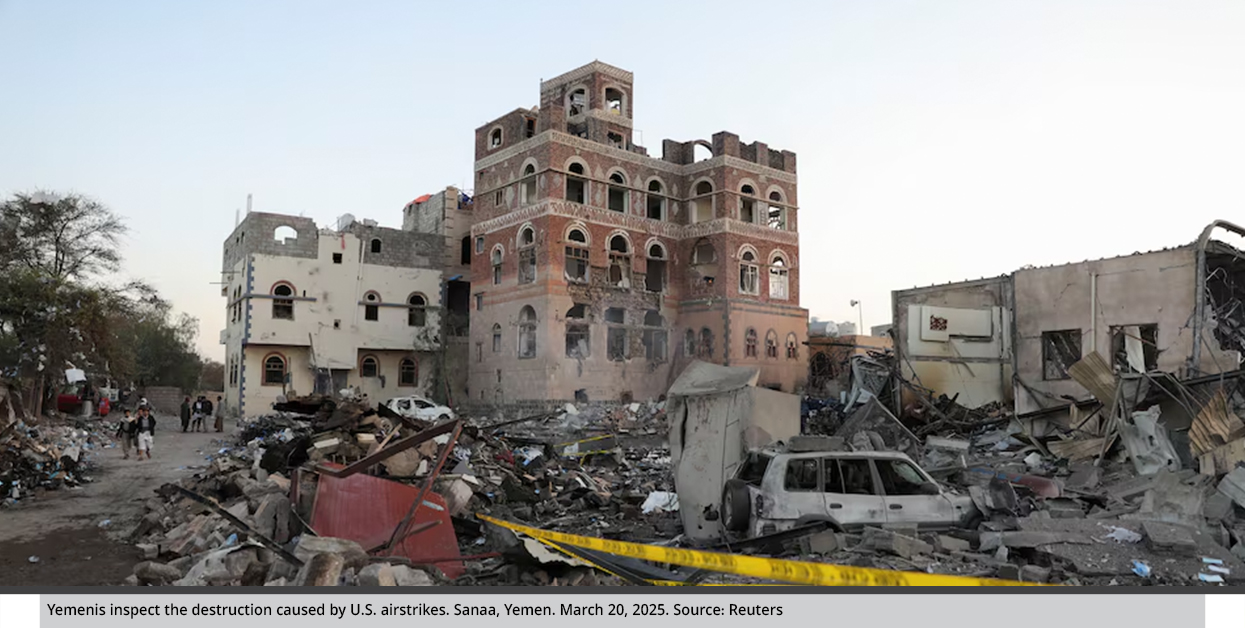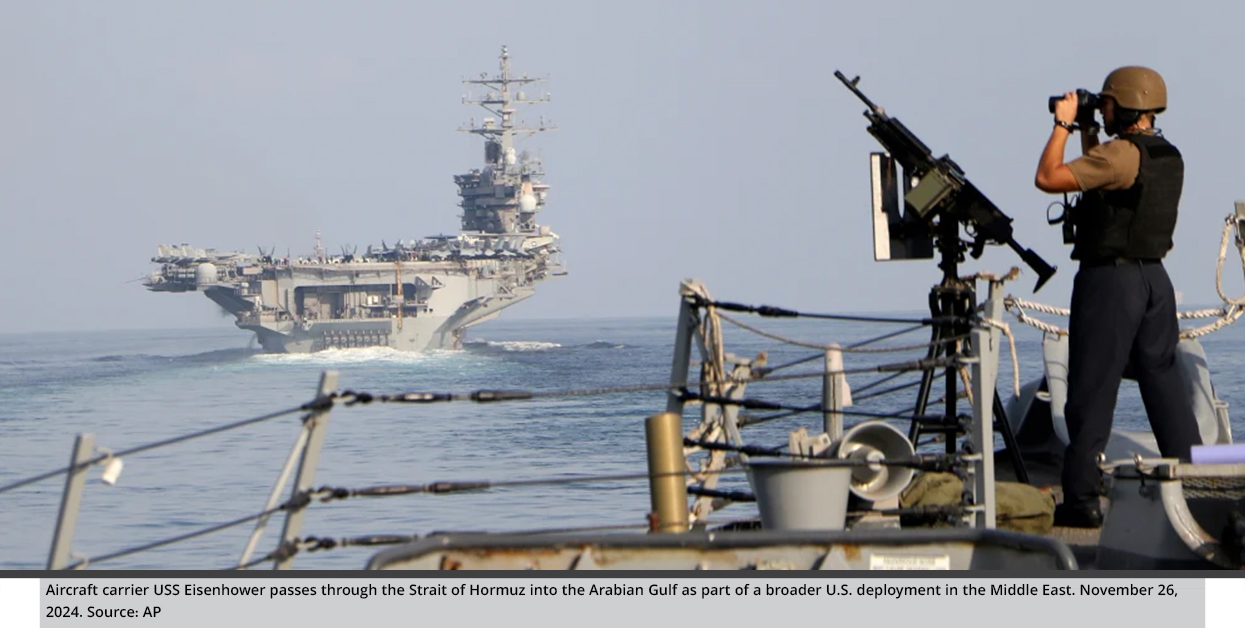The U.S. Military Strikes Against the Houthis: The End of One War or the Beginning of Another?
The American military strikes against the Houthis come in light of the ongoing developments in the war in Gaza and the Houthis’ indirect role in it. These strikes coincide with the return of the “maximum pressure” policy against Iran, which U.S. President Donald Trump introduced during his first administration. The strikes aim not only to separate the Houthis from the main war arena in the Gaza Strip but to also separate them from Iran.
by STRATEGIECS Team
- Release Date – Mar 27, 2025

The Yemeni arena entered a new phase of conflict after the United States launched a series of military strikes on March 15 that continue to this day. During this period, dozens of American airstrikes targeted Houthi-controlled areas in Yemen, as well as some of the group’s leaders. These strikes represent a fundamental shift in the U.S. approach to dealing with the Houthis. While the previous Biden administration adopted a defensive strategy, President Donald Trump’s administration is clearly pursuing an offensive approach.
This escalation comes as Israel resumed its war on Gaza after negotiations stalled on transitioning to the second phase of the conflict. At the same time, signs of a potential escalation between the United States and Iran are increasing, particularly after Washington gave Tehran a two-month deadline to reach a new nuclear agreement.
This raises a key question: Are the U.S. strikes against the Houthis in Yemen an American strategy to help end the war in Gaza or are they part of a broader U.S. military campaign targeting Iran and its remaining proxies in the region?
The Changing Pattern of U.S. Engagement
The American strikes came in light of the ongoing developments in the war in the Gaza Strip and the Houthis’ indirect role in it. The Houthis resumed their attacks on commercial ships linked to Israel in the Red Sea and the Gulf of Aden on March 11. On March 18, for the first time since the first phase of the Gaza ceasefire agreement took effect on January 19, they launched a missile attack on southern Israel. This was followed by Israel intercepting five missiles between March 20 and 25.
However, these strikes indicate a shift in the American approach between the two presidents. While former U.S. President Joe Biden focused on a defensive response—targeting missile storage sites, radars, and other military infrastructure used by the Houthis in their attacks on commercial ships in the Red Sea—he also left the door open for political or diplomatic options. He viewed the war’s main front in the Gaza Strip as a potential means to halt Houthi attacks. In contrast, Trump has taken a more aggressive stance, shifting the confrontation with the Houthis toward initiative and offense.
Two days after he was sworn in as president, Trump, on January 22, issued an executive order to reclassify the Houthis as a “foreign terrorist organization”—a designation that Biden had refrained from reinstating. Instead, in January 2024, Biden had opted to place the Houthis on the global terrorism lists, which primarily targets economic aspects. Trump’s designation, however, imposes broader restrictions, effectively banning any economic or political dealings with the Houthis and stripping them of legitimacy in the territories they control in Yemen.
The Trump administration expanded the list and scope of attacks to include Houthi infrastructure and all its leaders. In general, the American strikes reflect lessons learned from the Israeli war with Hezbollah, which demonstrated how non-state armed groups and factions can be eliminated or diminished through intense targeting of command structures and weapon storage areas. Notably, the U.S. military targeted the personal security chief of Houthi leader Abdul-Malik al-Houthi, as well as the commander of the Houthi navy, the group’s senior missile expert, and several other prominent Houthi leaders.
Additionally, the American attack was supported by extensive intelligence activity involving U.S. and British spy planes, advanced aerial reconnaissance, and surveillance systems. This approach seems to have motivated Trump’s vow on January 19 to eliminate the Houthis entirely. This could indicate that American strikes may target key Houthi leaders and high-ranking officials within the organization’s command structure.

American Strikes in Context of Escalation with Iran
The American strikes against the Houthis in Yemen coincide with the return of the “maximum pressure campaign” Trump implemented against Iran during his first administration (2016–2021). This shift is one of the key factors in understanding and interpreting the U.S. strikes, particularly as they come amid several developments in the escalating tension between Washington and Tehran. These developments include the sanctions on Iran’s oil industry and individuals linked to it implemented on February 6 and a letter Trump sent to Iran’s Supreme Leader, Ayatollah Ali Khamenei, on March 7 warning that a new nuclear agreement between the two countries must be reached within two months by engaging in direct talks with Washington.
The strikes launched by the U.S. military against the Houthis are aimed to separate the Houthis from Iran, not just from the main battlefield in Gaza. Trump closely associates the actions of the Houthis with Iran and holds the latter directly responsible for Houthis attacks. He has also relied on direct military threats against Iran, emphasizing that any escalation by the Houthis is a direct result of Iranian intervention. On March 15 Trump issued a direct warning to Iran to immediately stop supporting the Houthi terrorists. If Iran fails to do so, he added, the United States will hold it fully accountable and will no longer show any tolerance.
Trump further declared on March 17: “Every shot fired by the Houthis will be looked upon, from this point forward, as being a shot fired from the weapons and leadership of Iran, and Iran will be held responsible, and suffer the consequences, and those consequences will be dire!”
Moreover, the motivations behind the U.S. strikes are closely tied to supporting Washington’s policies against Iran. On February 6 Iranian Foreign Minister Seyed Abbas Araghchi wrote on X/Twitter that Iran will face the new “maximum pressure” campaign with “maximum resistance,” which, undoubtedly, will involve the Houthis again playing a direct and indirect role. Their past involvement included their attempts to target industrial facilities, airports, and vital energy infrastructure in Gulf countries, most notably the 2019 attack on Saudi Arabian oil facilities in Abqaiq and Khurais. With the return of the “maximum pressure” policies, it is clear that Washington aims to undermine any resurgence of “maximum resistance.”
However, in the post-October 7, 2023, region, Iran’s practice of “maximum resistance” has been significantly reduced. There is an increasing likelihood that the pressures on Iran and its proxies will lead Tehran to make substantial concessions in Iran’s foreign and nuclear policies. The targeting of the Houthis comes after the weakening of Hezbollah’s power, its reduced role in the Lebanese political arena, and its separation from the Iranian “unification of the arenas” strategy. Iran may realize that targeting Houthi leaders and their infrastructure not only isolates them from the “unification of the arenas” but also diminishes their power in Yemen.
The continuation of strikes and their deepening impact could place Yemen in a scenario similar to Syria, with the Yemeni army and the legitimate government preparing to reclaim sovereignty over Houthi-controlled areas. Given these developments, it seems plausible that Iran could eventually sit down at the negotiation table with the United States with more limited demands and fewer conditions.
The End of One War or the Beginning of Another?
Several indicators suggest that the United States may no longer be satisfied with only sanctions against Iran and that military action has become a viable option, especially given the diminishment of concerns that once dominated discussions of attacking Iran. Among the main concerns was the potential fallout on strategic straits, such as Bab al-Mandab and the Strait of Hormuz. However, U.S. strikes aim to deprive the Houthis of the ability to close Bab al-Mandab or cause significant disruption there. In light of the subsequent consequences of the war in Gaza, these concerns could potentially be mitigated if Washington decides to target Iran’s nuclear and missile infrastructure.
Among these indicators is the March 22 announcement by the U.S. Defense Department regarding the deployment of a second aircraft carrier to the Middle East, the USS Carl Vinson, and extending the presence of the USS Harry S. Truman, which is leading the attacks against the Houthis.
While the region had previously witnessed the simultaneous presence of two aircraft carriers during different phases of the war in Gaza, such as when the USS Gerald R. Ford was stationed in the Mediterranean while the Harry S. Truman was in the Red Sea and, later, when the Harry S. Truman and Dwight D. Eisenhower were both present in the Mediterranean. The previous deployments were for deterrence and defense purposes. In contrast, today’s deployment of a second aircraft carrier while the first is engaged in offensive combat missions suggests that the United States is focusing its military assets on combat and striking power, possibly preparing for a potential or imminent attack.

Finally, the U.S. strikes against the Houthis in Yemen appear to aim at ending their involvement in the war in Gaza, which has been ongoing since November 2023. At the same time, however, it aligns with Washington’s objective of amplifying the risks surrounding Iran and minimizing the risks associated with Iranian moves to undermine it, whether through economic sanctions or military strikes. In general, this move signals that military solutions are now on the table as an option, rather than just a threat or a warning. This suggests that American strikes against Iran are now plausible and potentially imminent.

STRATEGIECS Team
Policy Analysis Team
 العربية
العربية